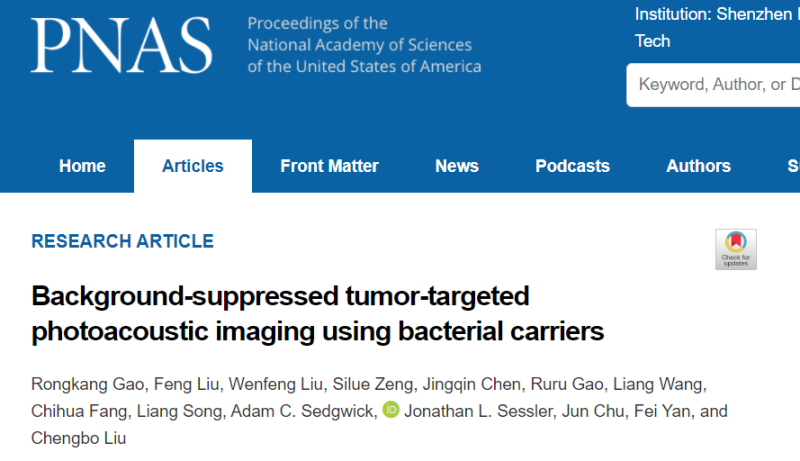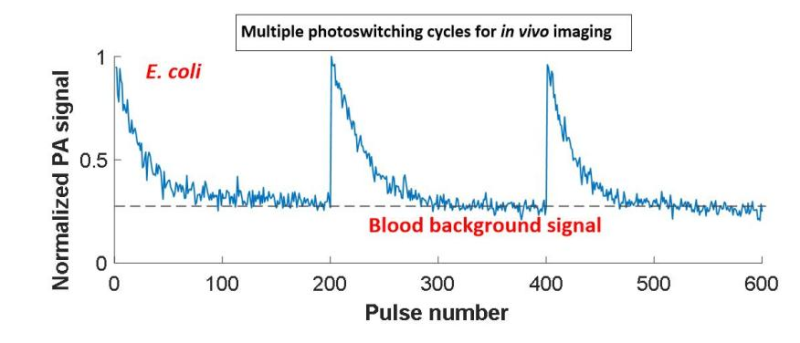On February 22nd, the team led by Liu Chengbo from the Institute of Biomedical and Health Engineering of Shenzhen Institutes of Advanced Technology, Chinese Academy of Sciences, the team led by Yan Fei from the Institute of Synthetic Biology and Shenzhen Institute of Synthetic Biology Innovation, the team led by Chu Jun from the Institute of Medical and Biological Engineering, in collaboration with the team led by Jonathan Sessler from The University of Texas at Austin, USA, published an article titled "Background-suppressed tumor-targeted photoacoustic imaging using bacterial carriers" in *PNAS*. This research achieved zero-background photoacoustic imaging targeted at tumors in deep tissues of living organisms. In this study, Shenzhen Institutes of Advanced Technology, Chinese Academy of Sciences is the first affiliation. Dr. Gao Rongkang and Dr. Liu Feng are the first authors, and Professor Liu Chengbo, Yan Fei, Chu Jun, and Jonathan Sessler are the co-corresponding authors.

Screenshot of the paper when it was launched online
We can enjoy the beautiful night sky dotted with stars and bathed in the bright moonlight at night. However, during the day, the moon and stars are no longer visible. It's not that they disappear; rather, due to the intense sunlight during the day, the moon and stars are obscured by the strong sunlight background. The same principle applies to biological imaging. In photoacoustic imaging, hemoglobin molecules in the body generate a strong background signal, greatly limiting the sensitivity and specificity of imaging other molecules, which are submerged in the strong background of the blood. Genetically encoded proteins with photoswitchable properties offer a way to solve this problem (Nature Methods, 2016, 67-73). These proteins can be imaged in two states, on and off, and the blood background can be effectively removed through differential imaging. However, this method has not been practically applied so far and can only achieve the differential imaging effect at the conceptual level. In this study, the researchers proposed a GPS strategy, providing an approach for the practical application of genetically encoded switchable proteins in living organisms. In the GPS method, G stands for Genetically Encoded Switchable Protein, P for Photoacoustic Imaging, and S for Synthetic Biology. The researchers designed and synthesized the F469W genetically encoded protein. Using the rules of genetic encoding, they transfected the plasmid of this protein gene into Escherichia coli E. coli MG1655. Leveraging the targeting property of this bacterium to the hypoxic microenvironment of tumors, the switchable protein gene was targeted and delivered to the tumor area. Through the photoacoustic imaging method based on the photoswitch, the background noise of the blood was suppressed to achieve the precise localization and photoacoustic imaging of the bacteria within the tumor. This method integrates genetically encoded switchable proteins, photoacoustic imaging, and synthetic biology, providing a new paradigm for the in vivo photoacoustic imaging of living cells such as bacteria, and has the following three advantages: (1) It eliminates the interference of the blood background signal through the strategy of differential signaling of the photoswitchable protein, improving the sensitivity and specificity of the detection by the photoswitchable protein probe; (2) By utilizing the targeting and homing ability of the bacterial carrier within the tumor, it provides a new means for the visual targeted delivery of gene drugs within the tumor; (3) The hypoxic and immunosuppressive microenvironment within the tumor allows the bacteria to proliferate inside the tumor, avoiding the limitation of the rapid clearance of traditional molecular probes in the body. Streptomycin can be used to remove the bacteria in the body after imaging, which is not only safe and controllable but also enables long-term imaging of the bacteria within the tumor, offering a new perspective for studying the growth and disappearance patterns of bacteria within the tumor.

(a)

(b)

(c)
Figure 1. (a) Schematic diagram of tumor-targeted imaging based on the bacterial delivery system; (b) Photoacoustic imaging results of the tumor area in a mouse when the genetically encoded switchable protein is in the ON and OFF states, as well as the result of background noise suppression achieved by the difference between the two; (c) The reversible change results of the photoacoustic signal from the ON state to the OFF state in multiple protein switching cycles within the Escherichia coli F469W vector